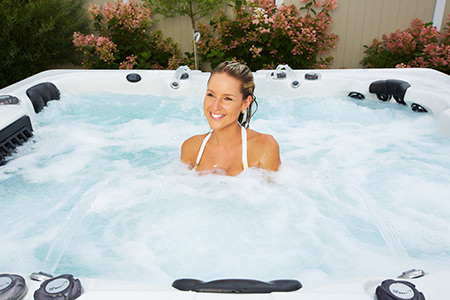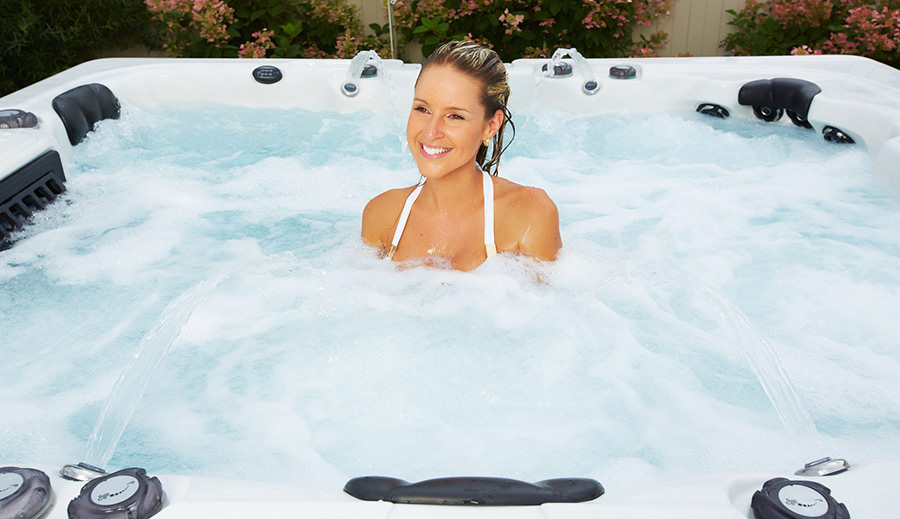
Saltwater hot tubs are becoming increasingly popular and are, in many ways, at the cutting edge of hot tub sanitisation technology. Many hotels and spas use saltwater systems and saltwater sanitization systems are being heralded as having huge advantages over more traditional systems like chlorine or bromine. They are said to need less maintenance, produce nisa feeling water and they are also supposed to be much better for the environment. In many ways, saltwater hot tub systems sound too good to be true! Are they really the new best thing in hot tubs or are there some disadvantages to them as well? Is it worth paying more for a saltwater hot tub system or possibly even converting your current hot tub? I decided to find out.
So, should I get a saltwater hot tub? Any hot tub can be converted to use a saltwater sanitization system. Saltwater systems are said to cause less irritation to the skin and eyes than traditional sanitizers, they are also supposed to need less maintenance and also be better for the environment. However, a saltwater system is more expensive, can cause corrosion to your hot tub and is ineffective at temperatures below 15.5 degrees Celsius.
How does a saltwater hot tub work?
The first thing to remember is that salt is actually called sodium chloride. To a certain extent, the clue is in the name and it’s the chloride part of sodium chloride that is released into your hot tub water. So basically the chlorine molecule of sodium chloride is released into the hot tub, however, the chlorine only occurs in small quantities and it is without the associated smell and irritation problems of using a full chlorine sanitizer. To release the chloride molecule there needs to be a tiny amount of electricity in the water. The process of electrolysis. So yes, if you have a saltwater hot tub you will basically be sitting in a tub of salty water with electricity in it as well! However, be rest assured that there is only a tiny amount of electricity needed and the salt content is significantly lower than you would expect too. In fact, you’re probably not even notice any salt taste to the water if you did actually taste it. A saltwater hot tub is nothing like sitting in seawater and the amount of salt in the water is, in theory at least, significantly less than our taste buds are able to taste.
In practice, there are two types of saltwater sanitizers. Stand-alone sanitizers and inline sanitizers. This is less complicated than it sounds in that the stand-alone version basically just hangs over your hot tub into the water and is connected to the electricity. The inline version is actually integral to your hot tub and is plumbed into the hot tub mechanism itself. Both versions use what is called a chlorine generator which is the part where the actual work is done. The chlorine generator reacts with the saltwater to create exactly the right amount of chlorine. In more sophisticated systems the chlorine generator will keep tabs on the water quality and will produce exactly the amount of chlorine that you need depending upon bather load.
The salt itself is literally added to the hot tub water. There’s no great science involved you simply add the correct amount of salt to the water. It’s not actually very much and you do need to use specific spa or pool salt and it’s also relatively inexpensive.
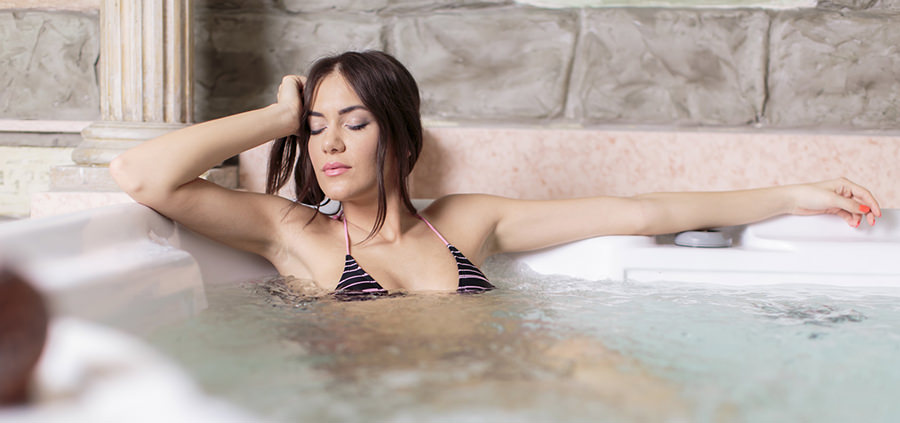
What are the benefits of a saltwater hot tub?
Fist of all let’s look at the many benefits of the saltwater hot tub system before going on and looking at a few of the drawbacks.
Water quality – Due to the fact that salt is added to the water, the water in a saltwater hot tub system is significantly softer than in a conventional system. It maybe sounds a little bit strange to think that soft water feels better but it does have a softer and more welcoming texture. Saltwater systems also look sparkly and appealing and there is a freshness and natural feel to the water. Another great advantage is that there is no irritation to the skin or eyes due to reactions to chlorine or bromine. Have a read here of my post which compares the pros and cons of using chlorine and bromine.
As I mentioned above the water doesn’t feel or taste salty at all. Relatively speaking the salt content is very low and doesn’t have an unpleasant effect on the water.
It’s better for the environment – Salt is obviously a naturally occurring substance and so, on the face of it, a saltwater sanitisation system does seem to be better for the environment. The alternative is filling your hot tub with man-made chemicals. The saltwater chlorine generator produces naturally occurring chlorine as well so there isn’t any environmentally unfriendly production process to worry about with the chemicals either. I have a whole post about the environmental impact of hot tubs which you might want to have a look at here.
In theory at least a saltwater sanitisation system uses less chlorine than a traditional system as in most saltwater systems the chlorine generator will produce exactly the amount of chlorine that needed at the time. In a traditional system there’s always the risk of overusing chlorine and also the issue of disposing of the chlorine filled water as well. Again in theory, once you are using a saltwater system and it is running correctly, there should be less need to balance your water or use any other chemicals in the hot tub, again which makes the system more friendly on the environment.
Apart from the environmental advantages, there has to be something more pleasant about sitting in a naturally sanitised hot tub than one that is full of man-made chemical. It somehow seems more wholesome and healthy. However, as we will see in a little while, saltwater sanitization systems aren’t actually 100% environmentally friendly.
Inexpensive to run – Once you have got a saltwater system installed or you have bought a hot tub which includes an inline saltwater system they are relatively inexpensive to run. You shouldn’t need to be buying liquid or tablet chlorine on a regular basis and your water chemistry should remain more easily balanced removing the need for adding PH raising and reducing chemicals to the hot tub on a regular basis. The main element that needs regular topping up and checking is obviously the salt content of the water. You do this in a similar way to checking any other of your levels in a hot tub with a special saltwater test strip kit. As with testing your water in a traditional system this is a cheap and simple process.
No smell or irritation – Many people find the smell of chlorine and also possibly bromine particularly unpleasant. It sticks to your skin and also your swimming costume and can also make your hair smell unless you give it a thorough wash after being in the hot tub. Many people find that chlorine irritates their skin and most people find that chlorine irritates your eyes if you get it in them. A saltwater system is much kinder to the human body and doesn’t cause irritation to the skin or eyes and it doesn’t produce a smell either.
The water only needs changing yearly – With a conventional sanitisation system in your hot tub you will need to change the water every 3 or 4 months. (Check out how to do that here) The great advantage with the saltwater system though is that the water only needs changing every year. Draining your hot tub isn’t a particularly difficult process but it can be time-consuming and a little bit tedious. You also need to take time to make sure that your water chemistry is correct after you refill the tub so it might be out of use for 24 hours or so. Obviously, if you’re only changing the water each year you will save time and there will be less times when your hot tub is out of action. There is also a water-saving advantage if you bear in mind that your hot tub might well hold 500L or so of water – if you feel this up three or 4 times a year this does add up to quite a lot.
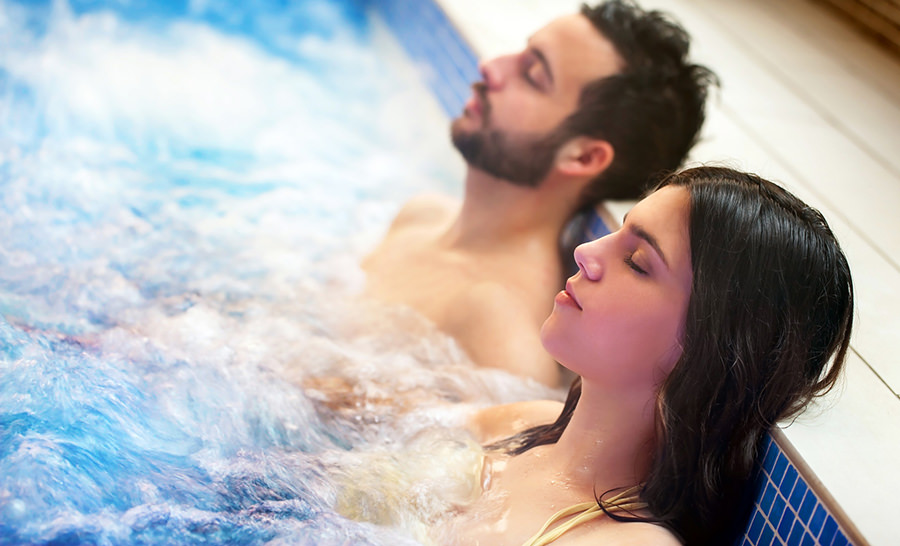
What are the problems with saltwater hot tubs?
All this sounds absolutely great and I have to say that, before investigating the disadvantages to the saltwater system I was pretty much sold on it has been a great replacement for chlorine. Let’s have a look through some of the problems with saltwater hot tub systems now.
Possible hot tub corrosion – Depending on where you read the issue with potential corrosion to part of your hot tub is either cited as a major problem with using saltwater or as something that’s not really of much importance. It stands to reason that if you have metal parts in your hot tub and you are exposing those metal parts constantly to saltwater you will get problems of corrosion. One of the main areas of concern is the heating element which will corrode quickly if it isn’t designed to withstand saltwater. There will be other metal parts on the hot tub such as connections and fittings and internal parts that you can’t see that could also potentially corrode badly too.
It’s possible to change your heating element so that it’s salt water proof and also to have a good look at your hot tub to see where you think the problems might occur. If you are doing a conversion of a current hot tub to a saltwater system bear in mind that if you do run into problems you may well invalidate your warranty if things go wrong. If you are in any doubt then you should check with your hot tub manufacturer to see what their view of using your in your hot tub with a saltwater system is. My sense is that if your hot tub wasn’t specifically designed for running a saltwater system you could potentially run into problems. This may not be such a big deal if you are running a relatively old hot tub that is out of warranty and where you may need to replace parts and maybe the heating element in the near future. However, if you have a relatively new hot tub which is still under warranty then changing to a saltwater system needs careful thought.
If you buy a new hot tub that is specifically designed for using saltwater sanitization and has a saltwater sanitisation system fitted then you would naturally expect that the parts of the hot tub would be corrosion proof and it wouldn’t be a problem.
Gradually raising PH – I have read some reports of problems with salt water systems in terms of the water gradually rising in pH longer the salt water system is in use. This may not be a problem in that you can add chemical to reduce the pH but the issue seems to be that a number of people are taking the manufacturer’s promises of less maintenance as fact and are neglecting to check their water chemistry particularly often. Rising pH can have a number of problems and can cause to corrosion of your hot tub and also skin irritation to the hot tub occupants.
Only works above 15.5 degrees C. – Annoyingly a saltwater sanitization system only works if the water is above 15.5 degrees centigrade. Saltwater systems tend to cut out below this temperature. This might not be a problem if you keep your hot tub on and at working temperature all the time however if you find that it’s a good idea to reduce the temperature for periods when the hot tub isn’t in use or if you wish to switch the hot tub off then you could run into all sorts of problems with the water quality when you switch it back on again. In many ways the only way around this would be to add chlorine and to shock the tub before reusing it. This will work but sort of defeats the whole object of having a saltwater sanitization system in the first place.
Expensive to set up – The initial outlay for a saltwater system is more than for a conventional sanitization system. You may well recoup the money over time as buying salt is significantly less expensive than buying chlorine or bromine but you also need to factor in the cost of regularly changing the chlorine generator cells. Depending upon the type of chlorine generator that you have this could be expensive.
You might need to shock/top up with chlorine – As I mentioned above, even with a saltwater sanitization system running you might need to shock the tub or top up with chlorine on a reasonably regular basis. Again, depending on where you read, some people seem to say that the saltwater sanitisation system is a sort of set it and forget it system without any problems but other people are regularly finding that they cannot use their hot tub without shocking it or adding extra chlorine as you would do in a traditional tub. Again this is a bit annoying – one of the main motivations for getting a saltwater system has to be one of not wanting to sit in a bath of man-made chemical, getting a hot tub that takes less maintenance and also one that’s better for the environment.
Environmental concerns – on the subject of the environment, as I mentioned above, the actual water and use of water, as well as the theoretical need to not use man-made chlorine, is a great environmental advantage. However, I’m not 100% sure at all that used chlorine generator cells can be recycled or are particularly environmentally friendly to produce in the first place. This may well change and there may be some manufacturers who have got round this problem but as far as I can see at the moment this is an issue. Bear in mind also that a saltwater sanitization system does use electricity and that the electricity does need to be on all the time. It’s only a tiny amount but it’s more electricity than you would use if you were using a traditional chlorine or bromine hot tub.
Slow to get going – Saltwater sanitised hot tubs can take up to 72 hours to start producing enough chlorine to make the water safe to get in. Bear in mind that you will possibly need to adjust the water chemistry before you set the sanitization system going as well and this might take up to 24 hours to settle down and balance out. This means that it could be 3 or 4 days before your hot tub is ready to use after filling it. This seems like a long time but bearing in mind that you should only need to change the water every year this does represent a time-saving when compared with the traditional system where the water needs draining and refilling every 3 or 4 months.
May produce too much or too little chlorine – There’s also the risk with a saltwater system that it will produce too much or too little chlorine. At least with a traditional system you will be in a regular habit of checking your chlorine levels and be in control of them whereas with the saltwater system you are really leaving it up to the chlorine generator to produce the right amount of chlorine. This could well work perfectly in a really good system but there are a number of reports that I have read of some systems where there is simply not enough chlorine and there is no way that the saltwater chlorine generator can keep up or where there has been an excessive amount of chlorine in the water. A traditional system offers a little more control over this.
Splash problems – This seems like a strange problem but during my research, I read of people having issues with saltwater sanitised hot tub water splashing onto decking and creating stains. I did read of one manufacturer recommending that you hose down your deck area if water from your saltwater hot tub spills on it. For me at least, life is too short and I really don’t particularly want this problem and it seems to be potentially a major drawback of the saltwater system.
It’s still chlorine – At the end of the day, even though the saltwater system is, in theory at least, a much more natural process, it’s still producing chlorine. You are still sitting in a vat of water mixed with chlorine which sort of defeats the object. The chlorine is a little more user-friendly than man-made chlorine but it’s still essentially based on the same chemical that we are trying to avoid!
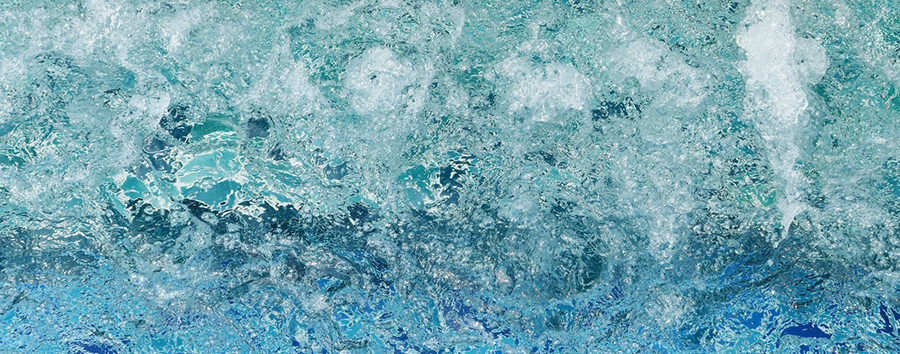
What are the alternatives to a saltwater hot tub?
So, what are the alternatives to the saltwater system? It goes without saying that we need some sort of sanitization system in a hot tub or else you would need to change the water every few days. Ideally, it needs to be environmentally friendly, cost-effective, easy to maintain and not have side effects of irritation to the skin and an unpleasant smell. I guess to a certain extent all systems have pros and cons but here are a few alternatives that might be a good idea.
UV sanitisation systems
One of the best alternatives to the saltwater system is a UV sanitisation system whereby the water is basically zapped by UV which kill any bacteria on contact. A UV system is extremely environmentally friendly and extremely efficient and also requires little maintenance.
Ozonaters
Hot tubs that using ozone is sanitisation system essentially allows ozone into the water which again reacts with bacteria and cleanses the water. Again this is relatively environmentally-friendly as the of the quantity of Ozone is tiny and it is a fairly simple efficient and low maintenance solution.
You can read about these systems in a bit more detail here.
However, all of these systems have drawbacks and one of the main ones is that they can be expensive to set up and expensive to run. I suppose there isn’t really an ideal sanitisation system for a hot tub and, as with many things in life, is the case of deciding which compromise you can live with. I have to say, that having read a lot about sanitisation systems on hot tub websites in the last few days, many of the manufacturers are really heralding the saltwater system as being the best solution out there. I guess if it’s of extremely high quality and is an inline system that is specifically designed for the hot tub and the hot and the hot tub is designed to cope with the saltwater system then it probably works extremely well. However, the cost issue, the environmental issues and also the problems of operating below 15.5 degrees, not to mention the staining splash problems are now actually really putting me off. Maybe in a few years time, the technology will be much better and saltwater sanitisation will be better.
In the meantime maybe the ideal solution is for a carefully monitored chlorine or bromine system possibly with an ozonator and also a good selection of carefully chosen water conditioners. This is tried and tested and is also significantly technologically further down its line of development than the saltwater system currently is.
How to change your hot tub to a saltwater system
However, that’s not to say that a saltwater system should be completely dismissed and you might well have come to the conclusion that it would be a great idea to use one. If you can, I would recommend buying a hot tub with a saltwater system already installed or at the very least having your manufacturer install and do the conversion of an inline system. However, if you want to go down the DIY root with a standalone system this is how to do it:
Flush your hot tub – Add a flushing solution to your hot tub water and then follow the instructions! Usually you need to leave the jets running for a while to flush out all of the gunk and biofilm from the hot tub’s innards into the water. It’s really important that you remove all traces of your previous sanitizer before changing to the saltwater system so don’t miss this out.
Drain the hot tub – Remove the drain plug and drain your hot tub. You can use a pump to speed up the process if you like.
Clean the hot tub shell – Use a proprietary hot tub cleaner to thoroughly clean the hot tub shell and all of the fittings. After you have done this the wash the hot tub down with clear water to remove all traces of the cleaning solution.
Refill the hot tub – Refill filtered water.
Check your water chemistry and add the salt – You now need to check your total alkalinity and PH levels before adding the correct amount of salt to the hot tub as per the instructions on the saltwater kit. You must use special pool/hot tub salt for this. Take you time to get the PH levels right as it will mean that you water will stay in better condition for longer. You can read more about this here.
Set up the chlorine generator – Read the instructions on the kit carefully and set up the chlorine generator. This is usually really simple and essentially involves plugging the generator into the electricity and then suspending it down the side of the hot tub into the water.
Related questions:
Can you convert any hot tub to saltwater? – You can convert any hot tub to salt water using a free-standing saltwater chlorine generator. Clean the hot tub thoroughly first to remove all traces of the previous sanitizer and read the instructions carefully. Bear in mind however that using a saltwater system could cause corrosion to your hot tub and might invalidate your warranty.
Are saltwater hot tubs more expensive? – Saltwater hot tub systems are usually more expensive to buy than more traditional systems but may be cheaper to run depending upon how expensive the chlorine generator cells are and how frequently they need changing.

